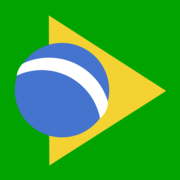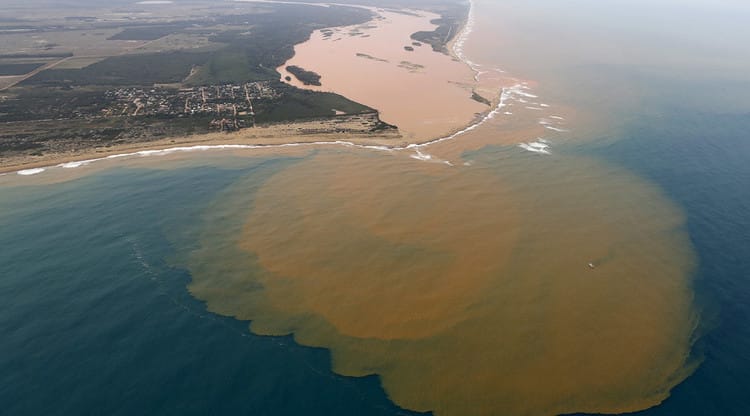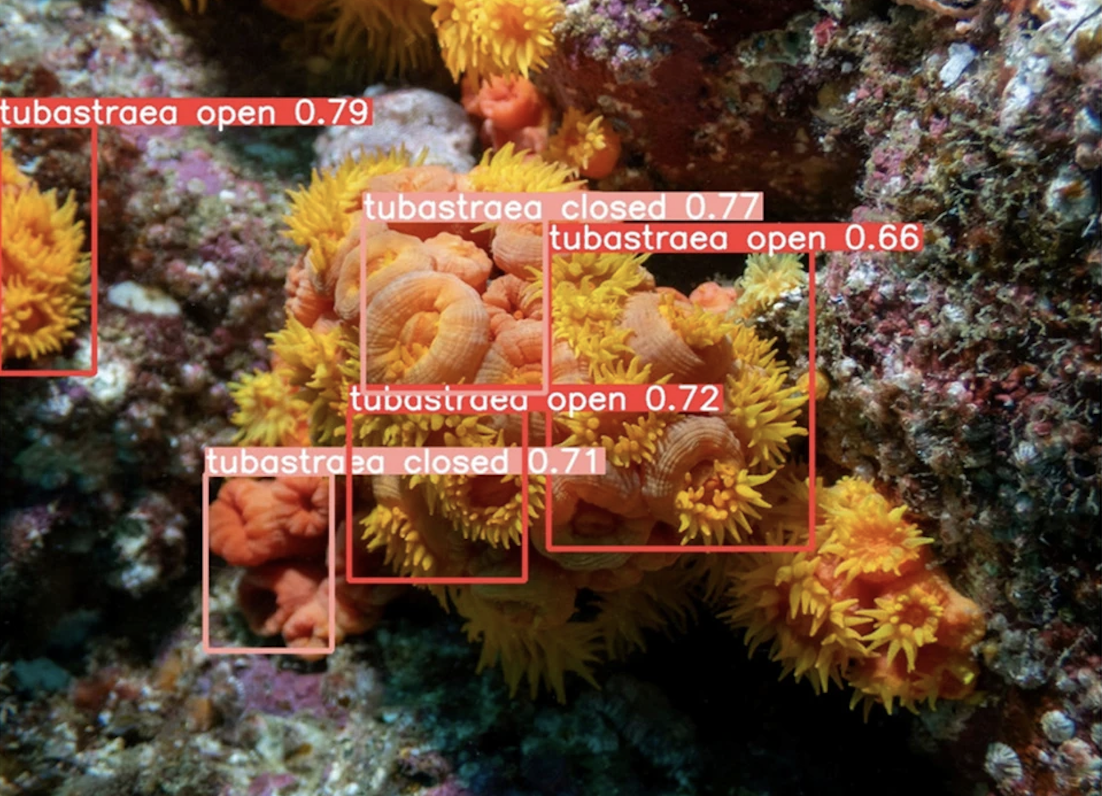Sun coral: data indicate stagnation in the species' dispersal in Arraial do Cabo
The freezing water temperature is believed to be the cause of the slowdown in the species' dispersal
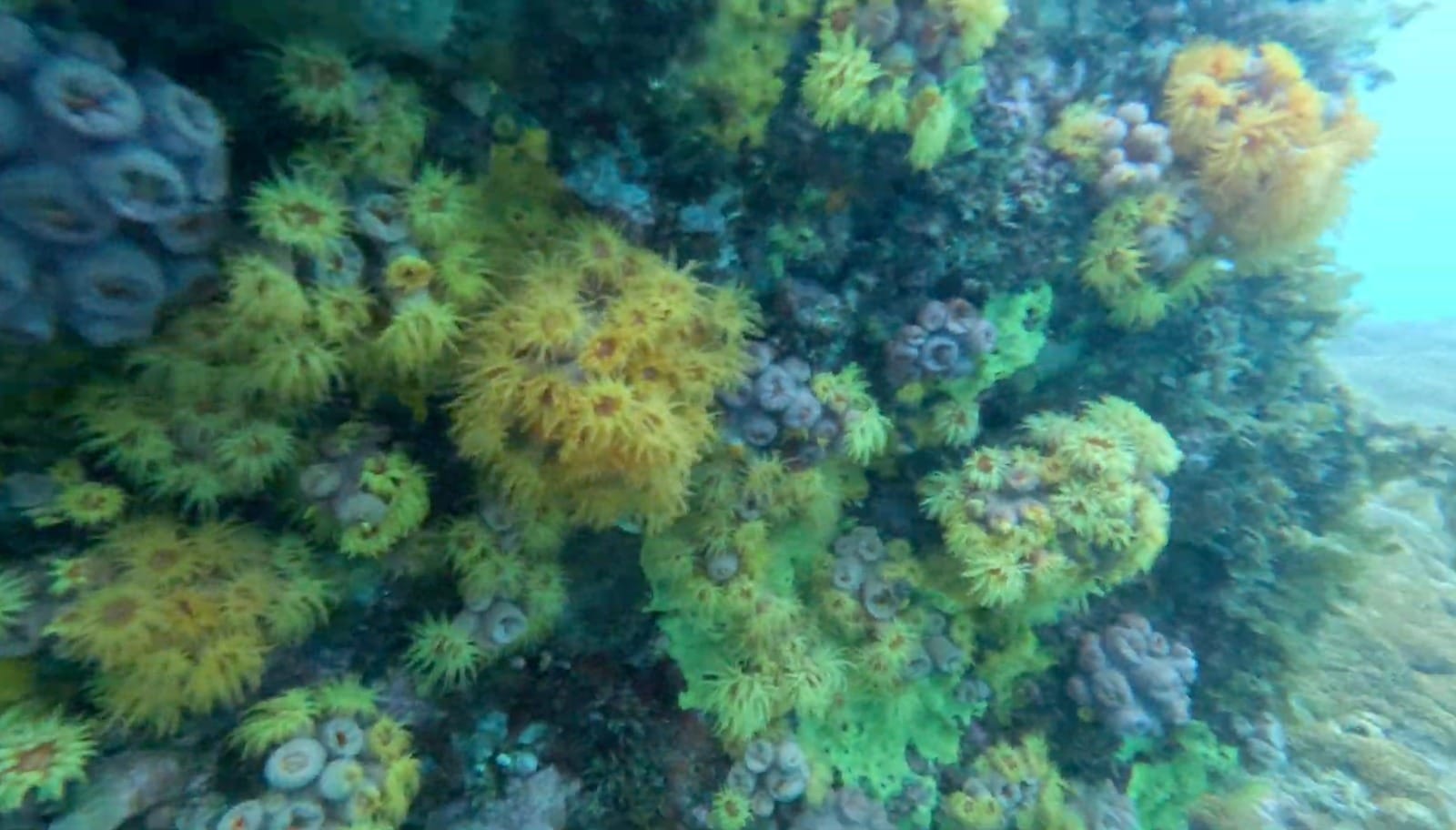
Data raises doubts about the impact of sun coral in Arraial do Cabo
The sun coral, an invasive species that has been spreading along the Brazilian coast since the 1980s, dominates rocky shores and diving areas, mainly in Angra dos Reis, in the state of Rio de Janeiro. In Arraial do Cabo, another municipality in the same state, where there are also records of the sun coral, the spread of the species has stagnated, and there are still doubts about the extent of its impact on marine biodiversity and the lives of communities that depend on the ocean.
For biologist and researcher Daniela Batista, associated with IEAPM (Admiral Paulo Moreira Institute of Marine Studies), Arraial do Cabo is not exactly a problem in terms of the dispersal of the sun coral.
In 2017, she mapped the species' distribution in Arraial do Cabo Bay, with the intention of comparing it to Angra dos Reis, where it was first identified on an oil platform. The discovery: the dispersal was under control.
"Around the mid-2000s, the sun coral was already seen in its natural environment in Angra dos Reis [and not just on oil platforms]. And, practically at the same time, they found [sun coral] here [in Arraial] as well. Years went by, and in Angra the sun coral began to dominate. There are several articles showing that it expanded about 2 km per year, and they started publishing several articles talking about the impact of the sun coral on native biota. And here in Arraial, when I did the mapping, we already saw a different pattern. It didn't spread as much as it did in Angra dos Reis," the researcher summarized.
Sun coral: weak in colder waters
One of the main hypotheses for controlling the sun coral in Arraial do Cabo is the cold water temperature:
"We saw that, due to the influence of the upwelling* of very cold water, which is below 12.5°C, the sun coral dies."
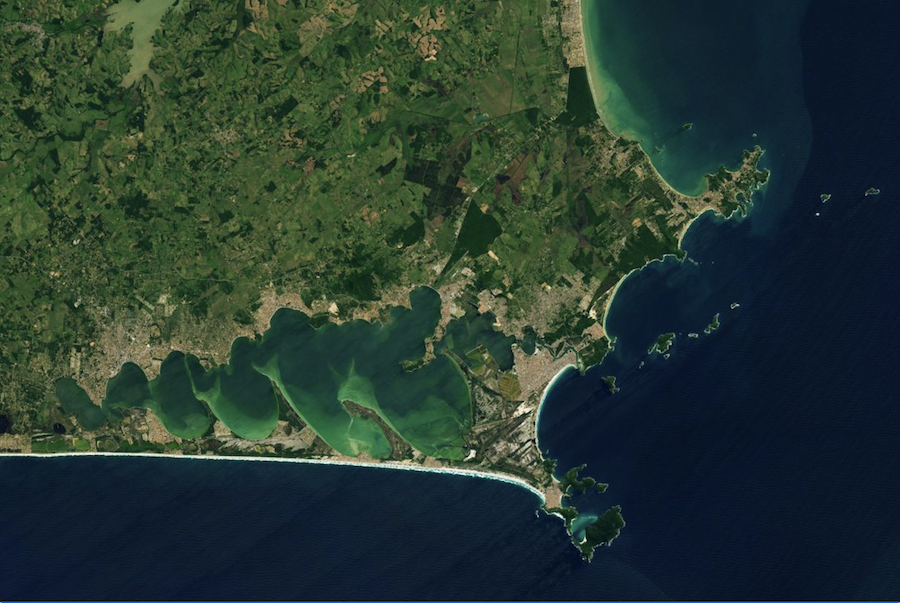
The impact of sun coral has limitations, professor emphasizes
Despite the perception of an immediate threat, part of the scientific community says that the impact of the sun coral on marine biodiversity is nothing compared to other factors, such as different types of pollution (plastics, oil, etc.) and overfishing.
Professor Carlos Eduardo Leite Ferreira, associated with the Department of Marine Biology at UFF (Fluminense Federal University) and coordinator of LECAR (Laboratory of Ecology and Conservation in Reef Environments), stated:
“The tendency of these exotic species in the sea is not to cause extinction [of others], but rather to compete for space, reduce other species, and then settle.”
“Cadu,” as he is known, said that the sun coral tends not to cause problems for fishing communities, both in Arraial do Cabo and in other biomes:
“It’s hardly going to interfere. What really threatens fishing communities is overexploitation and pollution. The exotic species is not the main cause of the lack of fish.”
Overfishing is a central point in the professor’s argument:
“The problem is overexploitation. In English, we call it overfishing. It’s been happening for 50, 100 years, combined with pollution and habitat loss.”
Although he considers it important to conduct research and monitoring of invasive species, Cadu said that excessive focus on the sun coral can even divert attention from structural issues that, in his view, are more relevant.
“We’re wasting a lot of time on this and forgetting the main impacts: exploitation and pollution. The exotic species is the least of our concerns.”
Monitoring of the sun coral draws industry attention
For biologist Daniela Batista, who mentions the stagnation of the sun coral’s expansion in Arraial do Cabo, the industry tends to be the most affected by invasive species.
“It’s hard to say exactly what the real impact [of the sun coral] is, but the fact is that we’re already seeing impacts in the industrial sector,” she said.
Click to see examples of how invasive species cause impacts in different areas
According to Daniela Batista, it was the very validation that the sun coral impacts industry that supported the creation of an initiative to monitor invasive species through computer vision (which will be detailed in the next content of this series).
“I said: ‘What if we use artificial intelligence to try to identify the coral in the video? That would make a big difference, right? It would greatly optimize the consultant’s time for this type of work.’ And we ended up using Arraial do Cabo as a case study. We took the videos and images from here so we could apply this on a national scale,” she said.
So, does the sun coral actually cause a problem?
Author of a project that uses computer vision and machine learning to identify the sun coral, biologist Ana Carolina Luz, who studies the species at IEAPM (Admiral Paulo Moreira Institute for Sea Studies), linked to the Brazilian Navy, explained in an interview with Correio Sabiá:
“The sun coral is an opportunistic species that competes for space and food with other corals and species associated with the substrate. It attaches, reproduces, and dominates these areas. (...) It monopolizes rocky shores, anchors there, and begins to compete for that space. The benthic community is the most affected.”
Therefore, the sun coral causes native species that live attached to the sea floor (such as algae, sponges, native corals, and invertebrates) to have less space and fewer resources available. This alteration in balance affects ecological dynamics and reduces local diversity.
“Studies show that this bioinvader has been responsible for modifying the benthic communities of rocky shores in the Ilha Grande region, Rio de Janeiro, and in coral reefs in Bahia, reducing the abundance of macroalgae. Nevertheless, an increase in species diversity was observed where Tubastraea was present. The increase in diversity may lead to a decrease in competitive interactions and, consequently, to a reduction in the abundance of competing species,” explained Ibama (Brazilian Institute of Environment and Renewable Natural Resources), Brazil’s environmental enforcement agency.
Ibama itself published in 2019 the National Plan for the Prevention, Control and Monitoring of the Sun Coral (Tubastraea spp.) in Brazil, which had already been made possible by a 2018 regulation.
Ibama emphasized that “the projected impact of the sun coral includes the expansion of its distribution area on natural substrates at an approximate rate of 2 km per year.”
The environmental enforcement agency provided the following overview of the sun coral’s presence in Brazil:
The expansion of the sun coral’s invaded area may occur through the gregarious recruitment of the species, ocean currents, transport in untreated and low-mobility small vessels, or by colonizing natural substrates from vectors close to the coast, including protected areas.
In this context, reef systems such as the Abrolhos Bank and the Coral Coast become extremely vulnerable, highlighting the importance of studies in these and other Brazilian reef systems.
There is no study confirming that the expansion of T. coccinea populations has occurred at the expense of the exclusion of any native species.
There is the possibility that there are available niches in the ecosystem that Tubastraea could efficiently occupy. There is also the issue of damage or loss among native species in the Western Atlantic caused by the invasion of T. coccinea.
Data on its impact remain scarce, except regarding its coverage and potential to monopolize benthic space.

Alcatrazes reveals the limits of sun coral control in Brazil
Over the course of a decade, the Alcatrazes Archipelago in São Sebastião (SP) has become a natural laboratory for managing the sun coral (Tubastraea spp.), one of the most aggressive marine invaders in the South Atlantic.
A study published in the journal Marine Pollution Bulletin reveals that, since 2014, about 1.3 million colonies—the equivalent of 12 tons—have been removed from the islands and rocky outcrops of the Alcatrazes Archipelago Marine Natural Monument, a fully protected area.
Despite the effort, scientists coined the term “short blanket” to describe the dilemma: controlling the invader in one spot often means seeing it advance in another.
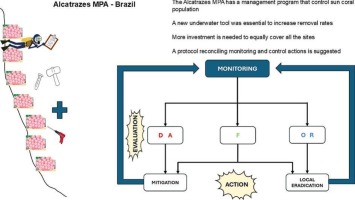
One of the main challenges in controlling the sun coral is that even small fragments of coral can give rise to new individuals. This makes complete eradication difficult—and each sun coral can produce up to 3,000 larvae in a single reproductive event.
In fact, this is why removal of the sun coral should be avoided during reproductive periods. Even well-intentioned efforts may have the opposite effect, since the species can generate new individuals even from fragments.

Moreover, the sun coral easily adheres to rocks, reefs, and boats, which facilitates its spread. Manual extraction, currently the most widely used method, is labor-intensive, expensive, and requires training. According to the study in Marine Pollution Bulletin, each day spent combating the sun coral costs about US$720. The total between 2015 and 2023 amounts to US$160,000.
Between 2014 and 2023, management efforts focused on only three priority areas. Starting in 2021, with the improvement of techniques—including the use of pneumatic drills to remove colonies stuck to the substrate—and more systematic monitoring of invasion hotspots, the control rate increased. However, results vary by location within the archipelago: while some spots remain free of the species for up to a year after intervention, others experience renewed population growth after just six months.
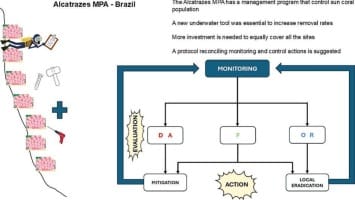
The study highlights that adaptive management was essential for adjusting field strategies and managing limited resources. The integration between monitoring and removal enabled the development of more realistic protocols for each area, considering the intensity of the invasion and the feasible effort. The authors argue that, in scenarios of budgetary constraints, it is not possible to apply the same level of control across the entire archipelago, making it inevitable to prioritize more vulnerable or ecologically sensitive locations.
The experience at Alcatrazes, according to the researchers, reveals the challenges faced by managers of marine areas in Brazil and other tropical countries. Since complete eradication is unfeasible, success depends on the continuous capacity to adapt, the engagement of local teams, and the maintenance of long-term investments. The case reinforces the urgency for specific public policies for marine bioinvasions, which are among the most underestimated vectors of environmental degradation in Brazilian oceans.
Overview
Ease of adaptation, differences in water temperature, and the number of larvae released during reproductive periods—all these are factors that influence the spread (or not) of the sun coral, as well as illustrating the complexity of the debate about this invasive species.
On one hand, divers—and Correio Sabiá’s own reporting team, which conducted scuba dives in Arraial do Cabo—witness the takeover of space by invasive colonies and the alteration of the marine landscape, which challenges the management of protected areas. On the other hand, scientists point out that the impact has limitations in the long term.
Still, Brazilian legislation recognizes the sun coral as one of the main marine invasive species. And the solution, as researchers advocate, lies in strengthening monitoring activities.
Support from the Earth Journalism Network
The series of reports “Sun Coral, an Invasive Species on the Brazilian Coast” is a production by Correio Sabiá and Ocean with support from the Earth Journalism Network.
This is because the founder of Correio Sabiá and Ocean, journalist Maurício Ferro, was one of the 16 selected in a global call by the Earth Journalism Network, being the only Brazilian in the group.
Throughout these days, readers will find information about this invasive species in bilingual versions (Portuguese and English). There will also be an audiovisual production to be released on the Correio Sabiá YouTube channel.
Autor

Jornalista e empreendedor. Criador/CEO do Correio Sabiá. Emerging Media Leader (2020) pelo ICFJ. Cobriu a Presidência da República.
Inscreva-se nas newsletters do Correio Sabiá.
Mantenha-se atualizado com nossa coleção selecionada das principais matérias.

